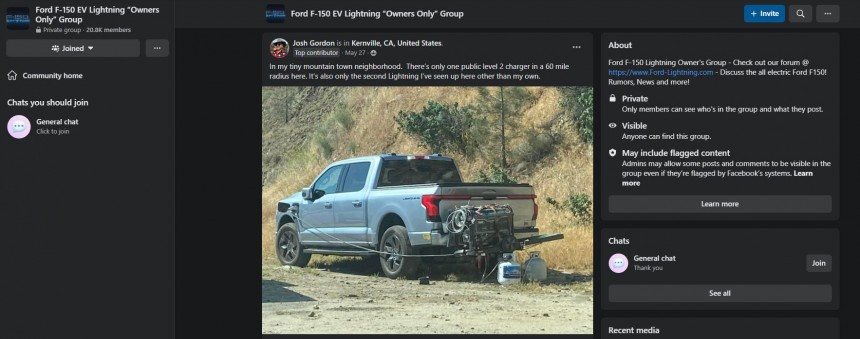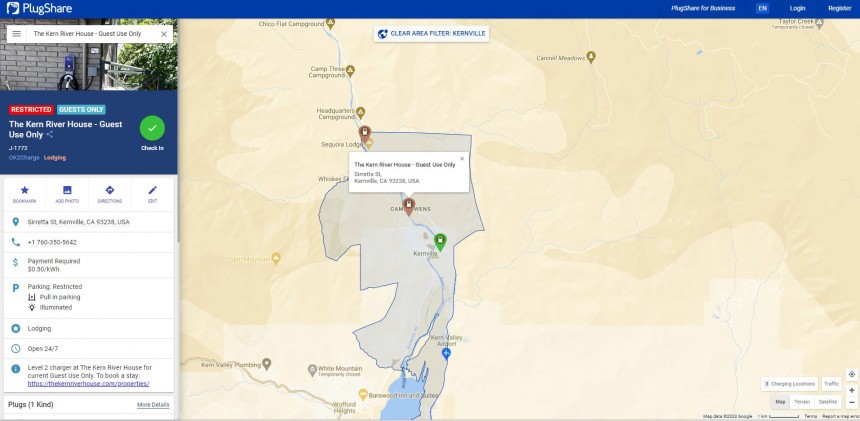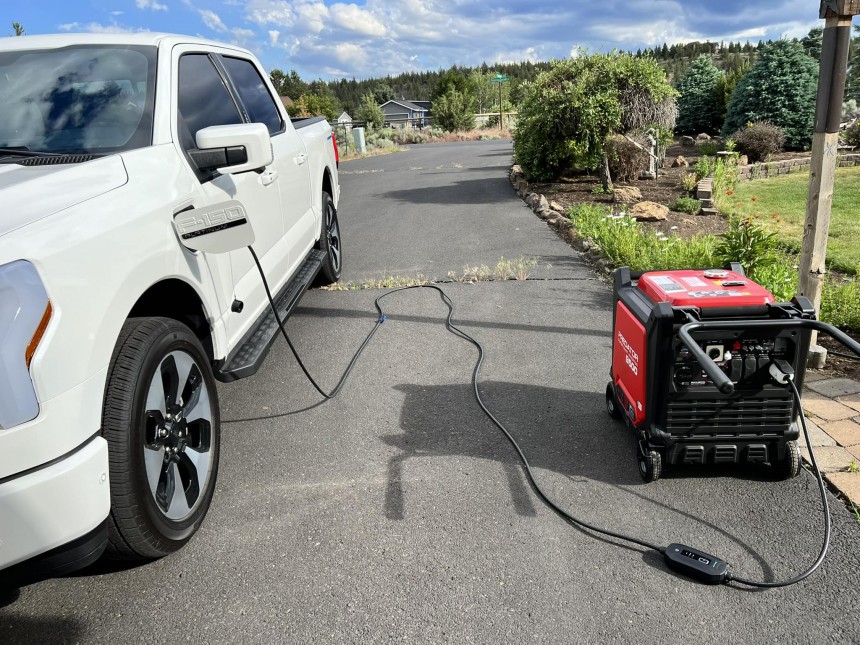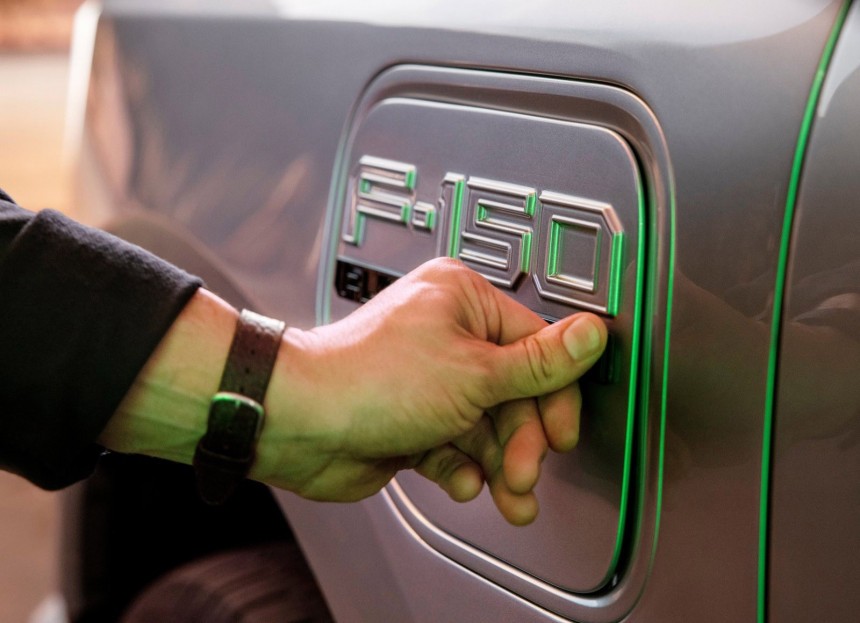It's a new world in the making. More and more carmakers are rushing to bring electric vehicles (EVs) of their own to the market. In an attempt to one-up Tesla, get ahead of General Motors, and hurt Rivian's R1T sales, Ford launched the F-150 Lightning. Now, an owner has found a way to never run out of electrons - they turned the EV into a temporary hybrid. Here's why it can be a great idea.
The Ford F-150 Lightning comes in many flavors, but the EPA-rated range on a single charge is 240 miles for the small 98-kWh battery pack (Standard Range) and 320 miles for the larger 131-kWh energy storage unit (Extended Range).
But that's what the lab testing says. In a real-world scenario, those figures will vary because batteries don't perform well when it's too cold or hot outside. Moreover, the range is impacted by the driving style as well.
Hoon it around, tow, carry a sizeable load in the bed, or travel at highway speeds when headwinds or crosswinds are strong and the range keeps dropping.
But the F-150 Lightning is, at the end of the day, a pickup truck. It must be able to do pickup truck things. And someone figured out a great backup plan to make sure the EV doesn't let them down.
Most laughed at the idea of seeing such a new EV on the side of the road using this clever charging method. As you may expect, many people didn't hesitate to say that the owner would have been better off with a traditional F-150. Others even advised the owner to sell the EV and buy "a real truck."
The all-electric F-150 is, for all intents and purposes, a real pickup truck. Even though it has a battery beneath its floor and magnetic motors, the vehicle can tow up to 10,000 lb and carry a load in its bed weighing 2,000 lb tops. It also comfortable seats five, and can act as a backup generator itself.
That brings us back to the image in question because there's some important context these netizens missed out on.
First, this photo isn't new. It surfaced on the Internet in late May. The author published it in a private F-150 Lightning Facebook group. Afterward, a member decided to post it on their profile. From there, it got shared everywhere for a few days. Later, the algorithm dialed its reach down, and making fun of the "hybrid F-150 Lightning" stopped.
Now, it has resurfaced. This time, it's being spread around nearly everywhere. We've seen it even on Instagram and Twitter (X).
But those who publish it disregard the story behind it because it's buried in that Facebook group. That's why social media users unaware of the image's origin are inclined to make fun of the owner and ridicule EVs in general. Everyone's entitled to their own opinions, of course. But one should always approach stuff seen on social media with care.
Second, the person who took the photo is also an F-150 Lightning owner. They explained that living in a small town around Sierra Nevada, California, is nice but comes with various challenges. One of them is finding proper fast-charging options.
Kernville doesn't pique the interest of providers like Tesla, Electrify America, Francis, or EVgo. There are some Level 2 chargers available, but they're installed by people running businesses who are unwilling to share them with anyone. It's complicated to make a living out of AC charging.
Plus, there isn't much tourist activity in the area, and only about 800 people live there.
Initially, what attracted his attention was spotting a fellow F-150 Lightning buyer in that area. Afterward, he noticed that the vehicle was charging and saw that a propane-powered generator was putting in the work. So, he did what almost anyone would do. They grabbed their phone and captured that moment.
Dependable DC fast charging is not a perk many Americans living in remote areas can access - for now. Federal funding will alleviate this problem starting this year. But until then, they need to come up with solutions that work. One of them is carrying around a portable propane-powered generator, and there's nothing wrong with that.
It's worth noting that using such a device isn't something groundbreaking or a simpleton's solution to a problem nobody should have in this day and age. BMW, for example, implemented a similar powertrain philosophy right from the factory for its i3 REx.
The EV had a 0.6-liter two-cylinder engine pumping out 34 hp. It was installed on the funky EV to give drivers a nifty failsafe, allowing them to keep traveling even after the battery tapped out.
The small powerplant ran constantly at an optimum level and acted as a generator for the battery. As such, the electric motor kept spinning and the gas consumption was low. That's how the i3 REx remained an EV after depleting its energy storage unit. The only drawback was that it temporarily burned small amounts of gas. But it did that very efficiently.
The generator consumes around 1.6 gallons per hour when it runs at 100% capacity. An average 15-lb propane tank available at Home Depot, Lowe's, or Walmart costs around $50. Consuming one full tank means the generator could run for a little over nine hours.
Minding heat losses, charging an EV with a 10-kW propane-powered generator could add around 90 kWh into the battery. That's nearly a full charge for the F-150 Lightning sporting the smaller energy storage unit.
But let's look at emissions because an EV is supposed to be green and beneficial to local environments. A portable propane generator emits half the CO2 emissions of an equivalent gas- or diesel-powered device. Moreover, when the generator consumes the propane, it gets released into the air, vaporizes, and dissipates. It's even more energy-efficient than natural gas and does not expire!
There is one downside, though. The portable generator is loud, and that might upset some people. Nobody wants to hear a "hrrr" or a buzzing noise for nine hours straight.
Ultimately, this Ford F-150 Lightning owner did turn their EV into a "propane-powered hybrid." But they did so only temporarily to get some electrons that enabled them to continue traveling without polluting. This was a good compromise, given their location and the lack of high-power chargers.
But I'll admit that it still looks a bit wacky.
But that's what the lab testing says. In a real-world scenario, those figures will vary because batteries don't perform well when it's too cold or hot outside. Moreover, the range is impacted by the driving style as well.
Hoon it around, tow, carry a sizeable load in the bed, or travel at highway speeds when headwinds or crosswinds are strong and the range keeps dropping.
But the F-150 Lightning is, at the end of the day, a pickup truck. It must be able to do pickup truck things. And someone figured out a great backup plan to make sure the EV doesn't let them down.
Figuring out the best solution
A photo of an F-150 Lightning charging on the side of the road attracted the attention of social media users on Facebook and Reddit. It wasn't damaged or vandalized, no. The EV was hooked to a generator! Right beneath it, two propane tanks were delivering the juice necessary to create electricity. That was enough to trigger a variety of responses, some of which were pretty wild.Most laughed at the idea of seeing such a new EV on the side of the road using this clever charging method. As you may expect, many people didn't hesitate to say that the owner would have been better off with a traditional F-150. Others even advised the owner to sell the EV and buy "a real truck."
The all-electric F-150 is, for all intents and purposes, a real pickup truck. Even though it has a battery beneath its floor and magnetic motors, the vehicle can tow up to 10,000 lb and carry a load in its bed weighing 2,000 lb tops. It also comfortable seats five, and can act as a backup generator itself.
That brings us back to the image in question because there's some important context these netizens missed out on.
Now, it has resurfaced. This time, it's being spread around nearly everywhere. We've seen it even on Instagram and Twitter (X).
But those who publish it disregard the story behind it because it's buried in that Facebook group. That's why social media users unaware of the image's origin are inclined to make fun of the owner and ridicule EVs in general. Everyone's entitled to their own opinions, of course. But one should always approach stuff seen on social media with care.
Second, the person who took the photo is also an F-150 Lightning owner. They explained that living in a small town around Sierra Nevada, California, is nice but comes with various challenges. One of them is finding proper fast-charging options.
Plus, there isn't much tourist activity in the area, and only about 800 people live there.
Initially, what attracted his attention was spotting a fellow F-150 Lightning buyer in that area. Afterward, he noticed that the vehicle was charging and saw that a propane-powered generator was putting in the work. So, he did what almost anyone would do. They grabbed their phone and captured that moment.
Crunching the numbers
But after taking a quick photo, the EV driver wondered if carrying around a generator as a backup solution was a good idea. They didn't rush to post the image online without helping others understand what was going on. So, the post was accompanied by enough explanations. It also helped that other F-150 Lightning owners shared similar stories.It's worth noting that using such a device isn't something groundbreaking or a simpleton's solution to a problem nobody should have in this day and age. BMW, for example, implemented a similar powertrain philosophy right from the factory for its i3 REx.
The EV had a 0.6-liter two-cylinder engine pumping out 34 hp. It was installed on the funky EV to give drivers a nifty failsafe, allowing them to keep traveling even after the battery tapped out.
The small powerplant ran constantly at an optimum level and acted as a generator for the battery. As such, the electric motor kept spinning and the gas consumption was low. That's how the i3 REx remained an EV after depleting its energy storage unit. The only drawback was that it temporarily burned small amounts of gas. But it did that very efficiently.
Does it really make sense?
But could buying a $2,000 propane generator that's pumping out 10 kW per hour at maximum capacity be worth it? Well, the short answer is yes. For this particular owner, it made a whole lot of sense.Minding heat losses, charging an EV with a 10-kW propane-powered generator could add around 90 kWh into the battery. That's nearly a full charge for the F-150 Lightning sporting the smaller energy storage unit.
But let's look at emissions because an EV is supposed to be green and beneficial to local environments. A portable propane generator emits half the CO2 emissions of an equivalent gas- or diesel-powered device. Moreover, when the generator consumes the propane, it gets released into the air, vaporizes, and dissipates. It's even more energy-efficient than natural gas and does not expire!
There is one downside, though. The portable generator is loud, and that might upset some people. Nobody wants to hear a "hrrr" or a buzzing noise for nine hours straight.
Ultimately, this Ford F-150 Lightning owner did turn their EV into a "propane-powered hybrid." But they did so only temporarily to get some electrons that enabled them to continue traveling without polluting. This was a good compromise, given their location and the lack of high-power chargers.
But I'll admit that it still looks a bit wacky.

















































